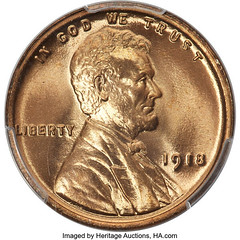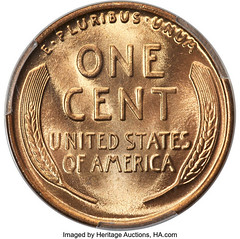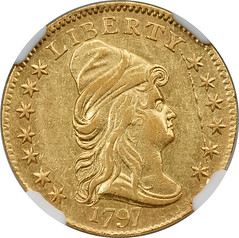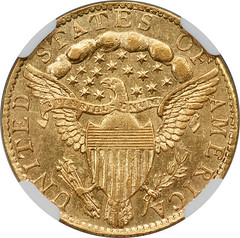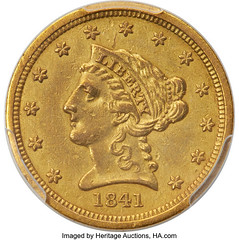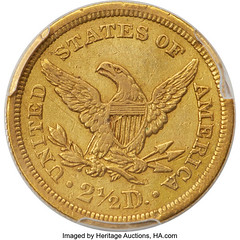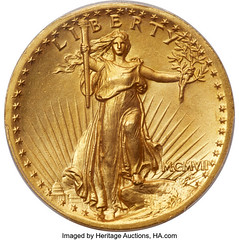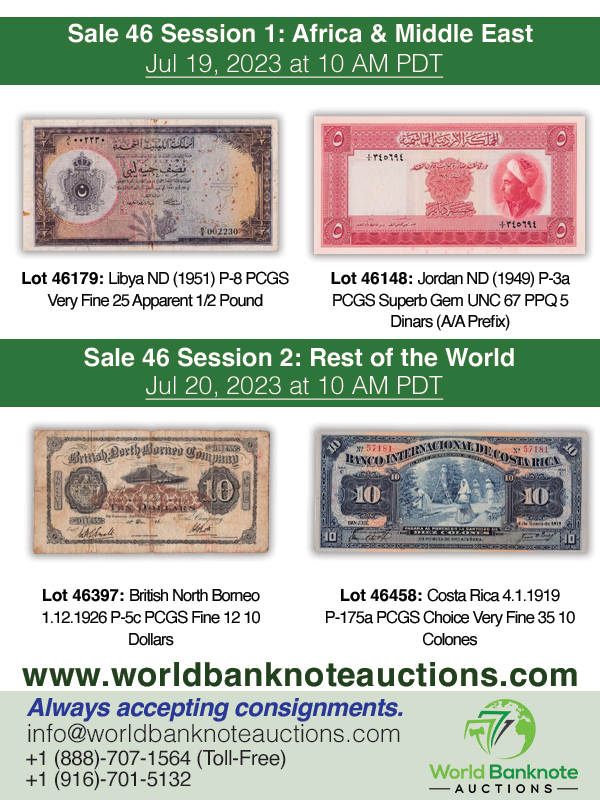
PREV ARTICLE
NEXT ARTICLE
FULL ISSUE
PREV FULL ISSUE
HERITAGE JULY 2023 SELECTIONSHere are some U.S. selections from the Heritage July 20-23 Long Beach/Summer FUN Auction, starting with a condition rarity. -Editor 1918 1C MS68 Red PCGS. The 1918 Lincoln cent is common in most grades and boasts a mintage of more than 288 million coins. To the perception of most collectors, there is nothing remarkable about this issue. However, for the advanced Registry collector, the 1918 presents a significant challenge. Red Superb Gem examples -- all but essential for a high-ranking Registry Set -- are rare. Yet, for the most advanced and ambitious collectors, even most Superb Gems will not do. For the fortunate few, the finest examples of this date known are three MS68 Red coins certified by PCGS (6/23). This coin represents the first appearance of an MS68 Red specimen in our auctions. Comparisons with even MS67 Red pieces that have come before is moot, since, in the world of Lincoln cents, there is a great expanse of rarity, value, and desirability between the two numerical points of MS67 and MS68. For collectors seeking the absolute finest quality, the 1918 is not a coin with a mintage of 288 million pieces; it is not a coin with a survivorship of tens of thousands; it is, rather, a coin with a population of three specimens.
To read the complete lot description, see:
1918/7-S 25C FS-101 MS64 Full Head NGC. By far, the 1918/7-S is the rarest issue in the Standing Liberty quarter series with Full Head designation. The FH population has gradually grown over the course of the last two decades or so as hidden pieces have made their way to the third-party graders, but the rate of new Full Head coin discoveries -- whether they be legitimate new discoveries or simply successfully upgraded non-Full Head pieces already known -- is glacially slow compared to the certification rate of other dates in the series. Moreover, the rarity of the overdate in Full Head is unlikely to ever be radically reduced by new certifications. This issue is inherently rare with Full Head detail.
To read the complete lot description, see:
1797 $2 1/2 BD-1, High R.5, AU55 NGC. Bass-Dannreuther Die State b, the obverse is cracked from the Y in LIBERTY, down through the right obverse field to stars 12 and 13. The obverse crack is seen on all examples of this issue, with a single low-grade piece showing a large rim break covering most of the right-side stars. Following the initial production of 66 quarter eagles that were delivered on September 21, 1796, mintages of this unwanted denomination remained small for many years. According to Mint records, fewer than 3,000 quarter eagles were coined during the first three years of the denomination, including 432 examples delivered on January 14, 1797, and a mere 427 coins delivered in three later batches in 1797. Today, we believe that the January delivery consisted of 1796 With Stars quarter eagles, and the later deliveries were coins dated 1797, though this is not absolutely certain. Only a couple dozen of those 1797 quarter eagles exist today, according to John Dannreuther, who estimates that 20 to 25 pieces are extant in all grades. It is likely that the obverse die cracked during the hardening process before any coins were struck, and Mint employees had no opportunity to create a new die before the coins were produced. Accordingly, the obverse failed quickly. The reverse die was used to strike the JR-1 1798/7 dimes as well as this quarter eagle variety, apparently after the quarter eagles, as none are known with the later die states that the dimes show. We have listed the 10 finest coins known to us in the list of Significant Examples below.
To read the complete lot description, see:
1841 $2 1/2 VF35 PCGS. Struck from the JD-1 proof dies (the only dies known), High R.6. The 1841 Liberty quarter eagle is one of the rarest and most enigmatic issues in the U.S. gold series. The 1841 Annual Report of the Director of the Mint does not list any quarter eagles produced at the Philadelphia Mint that year, but the coins have been known to exist since the time of issue. A specimen was placed in the Mint Cabinet in 1841 and Jacob Eckfeldt and William Dubois mentioned the issue, and provided an engraved image of an example, in their 1842 book A Manual of Gold and Silver Coins of All Nations. Mint Director James Ross Snowden also specifically mentioned the 1841 quarter eagle in his 1860 reference on the Mint Cabinet, but the issue seldom appeared at auction in the 19th century and little notice was taken on the rare occasions when a specimen was publicly offered. It was only when Edgar Adams mentioned that only two examples were known to him in his 1909 Official Premium List of United States Private and Territorial Gold Coins that the 1841 became a widely sought-after issue. By then, most of the coins had spent some time in circulation and high-grade specimens were prime condition rarities. PCGS CoinFacts estimates the surviving population at 16-17 examples in all grades, with survivors in both proof and business-strike format. We have traced 15 examples known to us in our roster below. Norman Stack apparently originated the "Little Princess" nickname for the coin in the description of the piece in the Davis-Graves auction in 1954, and it has stuck ever since. Since proof mintages were not reported in the annual Mint Reports of the 1840s, numismatists traditionally believed the unlisted 1841 quarter eagle was a proof-only issue. Some of the coins we know about today are obviously proofs, and all examples were struck from the same dies, reinforcing that theory. However, the number of survivors far exceeds the number of proofs from other years of this era, and the fact that most of the survivors show signs of circulation, rather than careful preservation, suggests that some of the coins may have been struck for commerce. Expert opinion is divided on this issue today and, since 2012, PCGS certifies coins in both formats, while NGC continues to certify all examples as proofs. We expect the last word on this subject has yet to be written.
To read the complete lot description, see:
1864 $3 PR64 Deep Cameo PCGS. CAC. JD-1, High R.6. Any proof three dollar gold coin is rare, broadly speaking; in fact, it is not much of a stretch to say that any unimpaired 19th century proof gold coin is rare, especially when one gets away from the one dollar gold denomination. The Mint reports of numbers of proofs struck bear little relevance in terms of pieces actually released to the collecting public (as opposed put into circulation). In the case of the 1864 proof three, the reported mintage was 50 pieces struck, all on February 11. How many of those were bought by the collecting public during that crucial Civil War year, however, is another matter. John Dannreuther estimates a mere 14 to 16 separate examples survive in all grades.
To read the complete lot description, see:
1907 $20 High Relief SP64 PCGS. Augustus Saint-Gaudens' iconic design for the double eagle was introduced in 1907, and the Philadelphia Mint struck a special limited mintage of 12,367 High Relief examples to illustrate the artist's original concept for the design. The coins were all specially struck from dies with almost three-dimensional sculptural design elements. Each piece received three blows from the high-pressure medal press to fully bring up the details of the design, with the planchet annealed between each striking to prevent breakage. Because the coins were all specially produced, many numismatists believe they should all be considered the same, either all proofs or all business strikes. Classifying a certain group of 1907 High Relief double eagles as proofs, or specimen strikes, has always been a controversial subject, but both NGC and PCGS have officially recognized some high-quality examples in these categories in recent times. While some prominent numismatists, like David Akers and Walter Breen, described certain High Reliefs as proofs in the 1950 through 1990 time frame, it was only in recent times that a specific set of diagnostics for proofs was established by NGC. These diagnostics are present on a single pair of dies, which was used in combination with a distinctive collar to strike only proof High Relief double eagles. The NGC guidelines are based on the use of Edge 3 or the "Edge B-II" collar that was used to strike the Ultra High Relief twenties from March to April 1907 and again on December 31, 1907.
To read the complete lot description, see:
Wayne Homren, Editor The Numismatic Bibliomania Society is a non-profit organization promoting numismatic literature. See our web site at coinbooks.org. To submit items for publication in The E-Sylum, write to the Editor at this address: whomren@gmail.com To subscribe go to: https://my.binhost.com/lists/listinfo/esylum All Rights Reserved. NBS Home Page Contact the NBS webmaster 
|
